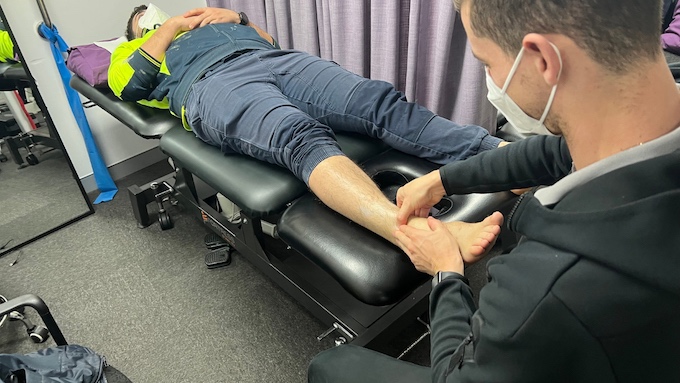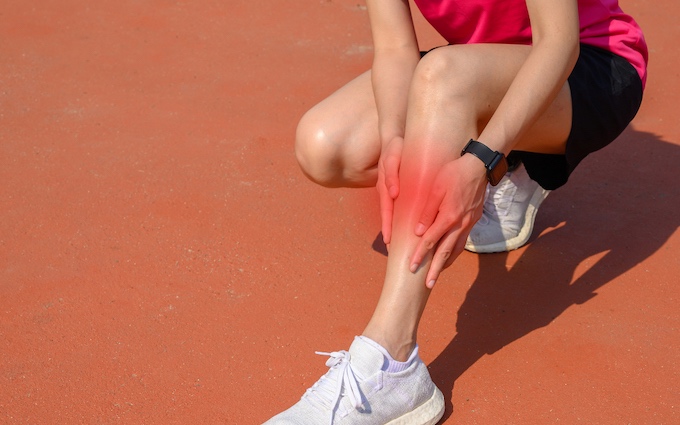Shin splints or Medial Tibial Stress Syndrome (MTSS) can be described as leg pain along the posterior medial border of the tibia (inside part of your shin bone). It is highly prevalent in both athletes and recreational runners with up to 35% and 20% experiencing MTSS in both groups respectively.
Shin Splints are generally associated with training/load management errors leading to chronic overuse of the muscles attached to the tibia, resulting in a bone stress response. Although activity aggravates symptoms, patient’s will often experience some relief with continued activity, however the pain then recurs after exercise and typically worsens the next day. Appropriate treatment and management have been shown to be effective in symptom relief and return to sport/activity. Poorly managed cases are at risk of developing severe leg pain, functional limitation and increased risk of developing a stress fracture

Signs & Symptoms
- Pain along the inside of the shin bone (approximately 10cm above the ankle joint)
- Pain with running and impact activities i.e jumping
- Pain at start of exercise, better during, pain during cool down
- Mild swelling over the lower leg

Risk Factors
- Excessive foot pronation
- Training errors/spikes in load
- Shoe design & poor footwear
- Muscle dysfunction
- Activity on hard surfaces
- Females are 3 times as likely
- High BMI
- Biomechanical dysfunction

Diagnosis / Assessment
- Tenderness along the medial portion along the distal tibia
- Increasing pain during exercise related activities to the distal medial tibial border
- Pain persists for hours or days after cessation of activity
- MRI can show periosteal reaction and edema
- Abnormal gait pattern
- Knee valgus, trendelburg sign, pronated/flat feet
- Poor muscle activation, poor stability or lack of endurance noted
Causes
MTSS is caused by repetitive stress to the periosteum of the tibia beyond the body’s ability to repair. Histological studies have now shown a lack of inflammation and periostitis, thus shin splints are more likened to a stress injury of the bone. The process is caused by spikes in training load, returning to activity too early and poor biomechanics. Historically, the tibialis posterior was thought to be the source of pain, but more recently the soleus and flexor digitorum longus muscles have been implicated. Activity involving excessive pronation and repetitive impact leads to chronic traction of these muscles at their insertions onto the tibia, resulting in pain.
What Does The Evidence Say?
Currently the foundation of treatment is based on symptomatic relief, identifying risk factors and training errors, treating underlying pathology and correcting biomechanics. Wilder et al (2010) advocates for the correction of key kinetic chain dysfunctions as part of treatment which can be achieved with manual therapy and exercise programs. The inclusion of cross-training with low impact activities to maintain fitness whilst a clinician leads return to full training is strongly recommended.
Strengthening exercises are widely accepted in literature as an integral component of recovery with Galbraith reporting eccentric calf exercises and strengthening of the foot inverters/evertors beneficial. Wilder et al (2004) and Strakowski et al (2006) examined common overuse and running exercises showing the benefit of strengthening hip, abdominal and core muscles to improve running mechanics to prevent lower limb injuries. Finally, Brukner & Khan (2017) support a graded return to running program as being essential to returning in a safe and timely manner after any bone stress injuries.
Why is physio important?
A thorough physiotherapy assessment can diagnose shin splints and identify training and biomechanical errors causing the injury, whilst also screening to exclude conditions like stress fractures and compartment syndrome that require different management.
Initially, physio will help with symptom relief via soft tissue techniques, stretches and exercises as well as educating on appropriate activity/load modification. Advice regarding taping, cryotherapy, orthotics and cross training can also accelerate recovery. Examination of the kinetic chain, joint/muscle deficiencies and analysing technique, all play a key role in improving symptoms, function and a safe return to sport ro activity. Our team of physios are experienced in developing individualised rehabilitation programs that will correct poor biomechanics, increase strength/endurance/muscle activation patterns and prevent recurrence of injuries. Primarily these programs address calf/soleus/tibialis posterior strength, intrinsic foot control, core and gluteal stability, general lower limb strengthening and progress towards functional training such as hopping and running drills. Integral to rehab is the safe return to specific sport/activity and our physios are best placed to lead a graded return to activity plan including the use of running programs, helping reduce the risk of re-injury and subsequent issues. Education on load management plays a huge role in this.


